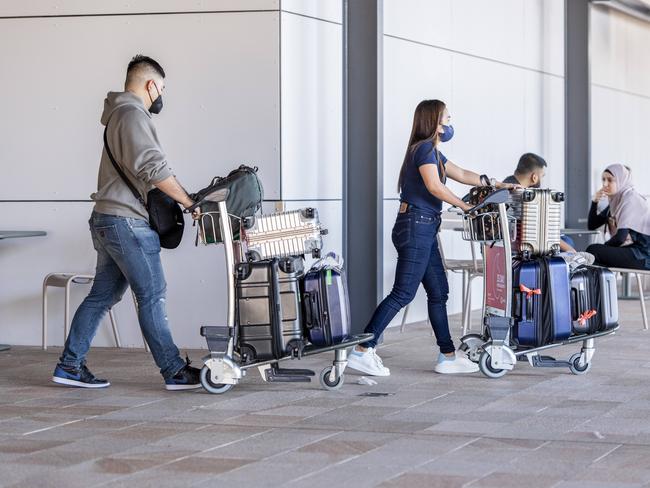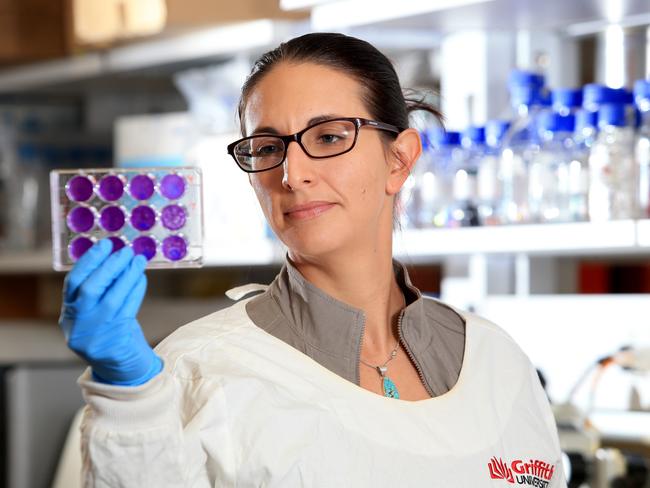New Covid NB. 1.8.1 strain: What are the symptoms and how effective are vaccines against it
A new highly contagious variant of Covid linked to a surges of cases throughout Asia has arrived in Australia, prompting expert calls for booster shots.

World
Don't miss out on the headlines from World. Followed categories will be added to My News.
A new, highly contagious Covid-19 strain which went on the World Health Organisation’s watch list just four days ago has already been detected in five Australian states.
The NB. 1.8.1 variant is behind a surge in cases across Asia including China and Hong Kong, where it is now the dominant variant, and Taiwan.
On Tuesday, cases of the new variant had been confirmed throughout the US, after first being detected in late March and early April among tourists arriving at airports in California, Washington State, Virginia and New York City, with additional cases reported in Ohio, Rhode Island and Hawaii.
In Australia, NB. 1.8.1 already accounts for 40 per cent of cases in Victoria and 25 per cent in Western Australia and New South Wales, around 20 per cent in Queensland and less than 10 per cent in South Australia.
In response, experts are urging Australians to get a Covid-19 booster, warning the surge in cases across Asia shows it spreads more quickly than other dominant strains of the respiratory infection.

HOW STRONG IS THE NEW VARIANT?
Griffith University virologist Associate Professor Lara Herrero said the new strain could possibly overtake others in Australia too.
“There is a prediction that this might start taking over other strains, but it’s early days, so we’ll just wait and see.
“We’re seeing a lot of cases in the community coming through the [emergency department] but it’s likely we’re heavily under-reporting because Covid reporting is no longer mandatory,” she added.
In Hong Kong, authorities say Covid-19 cases have spiked to the worst levels in at least a year following a “significant increase” in emergency room visits and hospitalisations in the past month due to the variant.

That included 81 severe cases in the past four weeks, including 30 deaths. The vast majority of the cases were in adults aged 65 and older.
In mainland China, the portion of patients presenting to emergency with coronavirus has more than doubled in the past month — from 7.5 per cent to more than 16 per cent, health authorities said.
The portion of people in hospital for Covid-19 in China also doubled, to more than 6 per cent, according to the state-run China Daily.
China’s airport tests revealed the extent to which the virus has spread as those infected with the new variant had travelled through China, Japan, South Korea, France, Thailand, the Netherlands, Spain, Vietnam and Taiwan.

WHAT ARE CURRENT COVID NUMBERS IN AUSTRALIA?
Dr Herrero said there had been ongoing regular infections since Covid was declared a pandemic more than five years ago and the number of cases had been slowly rising since May.
But federal data shows only 6.6 per cent of adults had received a Covid vaccine in the past six months.
“This new strain is a sublineage of Omicron and descends from the JN1 variant, which is what the current vaccine protects against,” Dr Herrero said.

“The flu is nasty this season too so I’d very strongly recommend everyone get their yearly flu vaccine and JN1 Covid booster — it’s the best way you’re going to be protected if you haven’t had Covid in the last six months.
“As the virus mutates, it gets a little sneakier and better at evading our immune response and antibodies.”
HOW EFFECTIVE ARE VACCINES AGAINST THE NEW VARIANT?
Sydney GP Michael Bonning said early reports showed the variant had a higher infection rate, but that existing vaccines were still effective.
“Individual variants are probably less important than overall societal factors such as whether people are keeping up to date with boosters,” he said.
Dr Bonning — involved in health policy advisory to Government and geriatric health — said respiratory infections were up nationally.
“We are expecting a spike in cases over the coming weeks with an expectation of a particularly difficult winter respiratory season because of what we have seen in the northern hemisphere,” Dr Bonning said.
“In New South Wales, in the past week there was an increase of 29.2 per cent in COVID-19 notifications, an increase of 25.9 per cent in influenza notifications, and an increase of 9.7 per cent in RSV notifications.”
HOW TRANSMISSIBLE IS THE NEW STRAIN?
According to the World Health Organisation (WHO), NB. 1.8.1 was first detected in January and declared a variant under monitoring earlier this month — a sign that it needs to be taken seriously, Dr Herrero said.
“That is not done with every variant — not at all — it’s ones that have specific mutations or if we have extra data that it might evade the immune system or transmit better,” she said.
“In this case, we’ve got mutations in the spike protein that seems to be making it easier for this virus to attach to our cells and it seems to be making this virus evade our antibodies better.”

WHAT ARE THE SYMPTOMS OF THE NB. 1.81 COVID-19 VARIANT?
Dr Herraro said there was no evidence to suggest the symptoms of the new strain were worse than other variants.
“We’re still seeing the same symptoms like fevers, cough, runny nose, headaches, some people are getting whole body aches and some are getting gastro symptoms,” she said.
“Wash your hands, don’t go out in public if you’re sick and spread it to everyone, get your vaccines if you want them. If you’ve got a cough or cold I’d wear a mask because you don’t want to share that with other people.”
WHERE HAS THE NEW COVID VARIANT SPREAD TO
Internationally NB. 1.8.1 is growing. By late April 2025, it comprised roughly 10.7 per cent of all submitted sequences – up from just 2.5 per cent four weeks prior.
While the absolute number of cases sequenced was still modest, this consistent upward trend has prompted closer monitoring by international public health agencies.
Cases have spiked in China, Hong Kong and Taiwan, and cases are rising in the US.
According to the WHO, as of May 18, 2025, there were 518 NB. 1.8.1 sequences from 22 countries, representing 10.7 per cent of the globally available sequences in the week of 21-27 April.
It did not list the 22 countries.
While the WHO considered this to be “low number”, it said it is a significant rise in prevalence from 2.5 per cent four weeks prior in the week of March 31 to April 6.
More Coverage
Originally published as New Covid NB. 1.8.1 strain: What are the symptoms and how effective are vaccines against it


